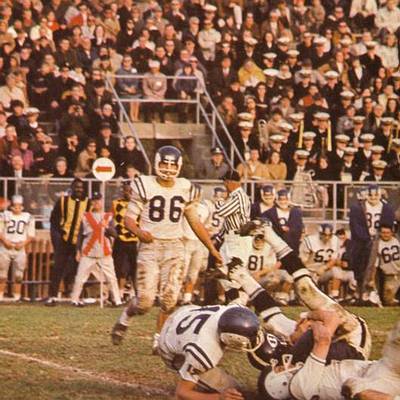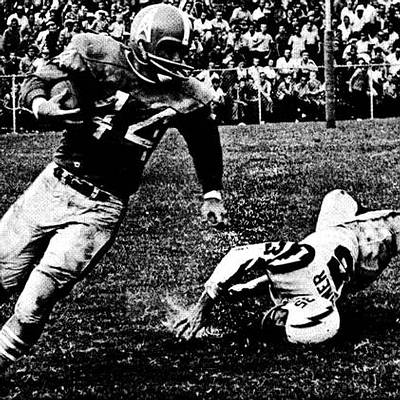

"Small School.... Big Memories Part 3"
HELMET HUT NEWS/REFLECTIONS December 2010:
Small Schools Can Hold Big Memories, Part 3
By Dr. Ken
As each Sunday evening’s BCS rankings become the focal point for the obsession of many college football fans, the recent HELMET NEWS/REFLECTIONS columns that have discussed “Small College” football played in the suspension helmet era have received excellent critical comment. My first exposures to collegiate football as long time readers of this column know, came from the small black and white Dumont television set that flickered in the corner of our living room. Army, Auburn, and the Big Ten teams were those that drew the most coverage in the mid to late-1960’s so it was natural that my allegiance and interest went to schools at that level.
|
|
“By the somewhat arbitrary decree of the Football Writers' Association of America, there are this fall 112 ‘major college’ football teams in the country. All the rest, some 624 of them, are ‘small college,’ a misleading phrase that provides a convenient catchall for enrollments ranging from 300 to 15,000. The small-college category has, in fact, nothing at all to do with a school's size but only with the quality of football competition it schedules.
One need only watch some small-college games to know there is nothing little league about the football. The NFL certainly didn't think so last winter when it drafted 50 athletes from the small colleges on the reasonable assumption that a few of them will prove as worthy as predecessors like Roosevelt Brown and Andy Robustelli of the Giants; Ed Brown, Willie Galimore and harlon hill of the Bears; and John Baker of the Rams.
This year they will be drafting more. In fact, Guard Doug Brown, a 1960 Little All-America who has a year to go at Fresno State, has already been selected by both the Los Angeles Rams and the Dallas Texans. There are three other Little All-Americas (second team) returning this fall who will bear close watching—West Chester (Pa.) State Fullback Joe Iacone, for instance, the stubby, broad-armed young man shown above. As a sophomore Iacone crushed the bid of Northeast Missouri's Dale Mills to win his third straight national rushing crown. Last fall he gained nearly a mile (1,438 yards, to be exact), finishing the season with a wild, 199-yard day against Lock Haven.”
West Chester State
College was typical of
small college ball in
the late 1950’s and
early-‘60’s with most of
its players coming from
the surrounding locales.
New York City area
players often made their
way to West Chester,
Wilkes, Lock Haven, and
the other “small”
schools that dotted the
football friendly
environs of
Pennsylvania. Iacone
however, stood out and
when my cousin
introduced me to what
looked like a short
mound of muscle, I was a
bit overwhelmed. Still
in junior high school,
my fortuitous meeting
with this Little All
American came at a time
when having a football
hero served an extremely
positive purpose. That
he gave me a “gee whiz,
work as hard as
possible, and do
everything right”
lecture only served to
make my admiration for
him stronger. Needless
to say, I became a
follower not only of his
career which eventually
wound its way through
the Philadelphia Eagles
as their eighth round
draft choice and camp
with the Patriots, but
also of small college
football and those who
made the Little All
American team. He served
as a long time coach at
The Haverford School and
was a revered member of
the faculty until his
retirement in 2008. This
one player was the spark
that made me aware of
small college football
and that expanded to an
interest in the local
Long Island schools.
That Hofstra and C.W.
Post Colleges played an
excellent brand of
football throughout that
same time period, opened
up an entirely new and
unknown world.
 |
U.S. Merchant Marine Academy at Kings Point tussles with Hofstra in early-1960’s Long Island game
With the birth of the American Football League that featured many “small college” players that I had not previously been aware of, and I became even more interested in these little known schools.
 |
Northwestern State of Louisiana’s Charley Tolar starred with the early Houston Oilers
My usual form of
leisure time
activity was to
memorize entire
team rosters. I
began doing this
for the twelve
National
Football League
teams as soon as
I figured out
the distinction
between college
and professional
football. I knew
the vital
statistics of
the collegiate
stars I was
aware of or as
these were
discussed in the
weekly broadcast
of college
games. The AFL
had so many
“lesser known”
players that
this was a
fertile field
for exploration
which enhanced
my awareness and
knowledge of
small college
players. For
every Billy
Cannon, Charlie
Flowers, and Bob
White that
entered the
league, there
was a Charley
Tolar of
Northwestern
State of
Louisiana,
Lionel Taylor of
New Mexico
Highlands, and
Gene Mingo who
did not attend
college at all.
What for me was
the new world of
small college
football, grew
exponentially
larger, more
interesting, and
exciting.